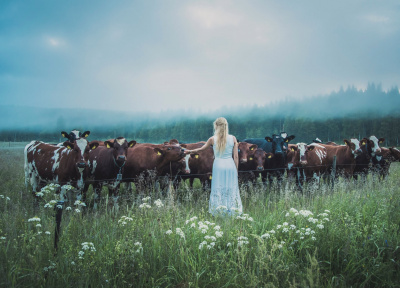Norway Imagined
Date posted
In this video Jonna Jinton from Sweden sings a home-made adaptation of old Scandinavian cattle calls (Facebook n.d.a., n.d.b.). A cattle call was a traditional way of calling the cows back from the pastures. This type of song, cattle call (called "kulokk" in Norwegian) was used by women who both looked and dressed very differently, and also sang differently, and it ceased to be used more than 100 years back.
As a Norwegian I get upset at this misuse of the old Norwegian folk culture trait of using cattle calls to get the cows to return to the farm for milking. Nothing here is traditional – very long, blond, loose-hanging hair, a white, sensuous nightgown, and the fact that it is late evening (when cows normally since long would have been milked).
Why Is This Not Good?
Because it is NOT an effort to present old Norwegian folk culture. Instead it is an effort to emulate values and emotions that some people want to present and share about what Norwegian folk culture is (read: was). Even more to the point: this is an effort to portray a picture of Norwegian culture that they, as well as foreigners/outsiders, want to hear, see, and believe in. That is, Norway – and Scandinavia more generally – as a nature-focused, sensuousness-in-nature, romantic, mystic place, one that is inhabited by tall, blond, beautiful people. On a generalized macro-level, this type of activity contributes importantly to creating wrong facts and truths – of constructing myths, as it were. This happens when we are so removed from reality that we end up with stereotyped views about other countries, cultures, and people. This does not further realism, understanding, and communication between peoples and cultures.
Why Is This Done?
There are at least three different sets of rationales at work here:
- There is a view, shared by many, that everything was better before. We hark back to the days of yore, when things were simple, life was hard but fulfilling, sin (including in its religious connotation) had not entered the world, corrupt politicians did not exist, exploitation was minimal (or so we believe), and so on.
- From an economic point of view, this is done consciously in order to sell Norway as a tourist destination.
- Another rationale is provided by people who have adopted a Norse way of life. The video was posted on the Facebook page "Nordic Sisterhood" who cater to a large number of people globally who do not just like Norse mythology, but believe in it and live it. The page represents and cater to this – to my mind, rather strange – sub-culture, who consists of women who dress in perceived Viking cloths, act Viking battles, eat whatever Vikings eat, adopt Norse religion, have a strong focus on the wolf and animals from Norse mythology, favor runic inscriptions, celebrate Yule instead of Christmas, are into special tattoo designs, and promote and believe in a special strong womanhood. And so, for this group, the cattle calling girl fits right into their view their world view.
Oh, by the way, the cows do not come because of the "old vibrations in the calling tones" (another effort to create mysticism and mythologize that has no base in reality). And the argument that this is "a stunning example of humans interacting with nature" is pure nonsense. It is also not a case of "mastering an old technique" as it is the simple fact that the cows come when anybody calls. They come because they are curious, because it is evening, because they, like us, are creatures of habit, and, finally, because their udders are full and they want to be milked. It is a case of straightforward Pavlovian reflexes.
Lars T. Soeftestad
Notes
(1) Nordic Sisterhood, URL: www.facebook.com/nordicsis (cf. also Nordic Brotherhood, at: www.facebook.com/NordicBrotherhood).
(2) An earlier version of this article was posted on Facebook 8 January 2017.
(3) Image credit: Video 1 (see Sources).
(4) Relevant Devblog articles: "Appropriation of Indigenous Cultural Property" at: https://devblog.no/en/article/appropriation-indigenous-cultural-property
(5) Permalink. URL: https://www.devblog.no/en/article/norway-imagined
(6) This article was published 11 January 2017. It was revised 21 January 2019.
Sources
Facebook. n.d.a. Video 1. URL: www.facebook.com/nordicsis/videos/1237867649558970/
Facebook. n.d.b. Video 2. URL: https://www.facebook.com/culturetrip/videos/662396607478939/
https://www.youtube.com/watch?v=nyuRRWC5GY8&feature=youtu.be

Add new comment